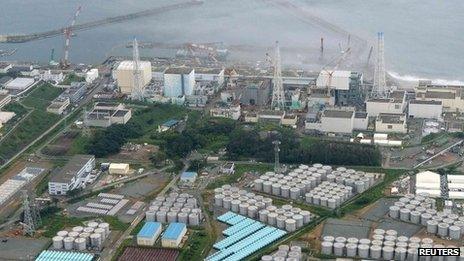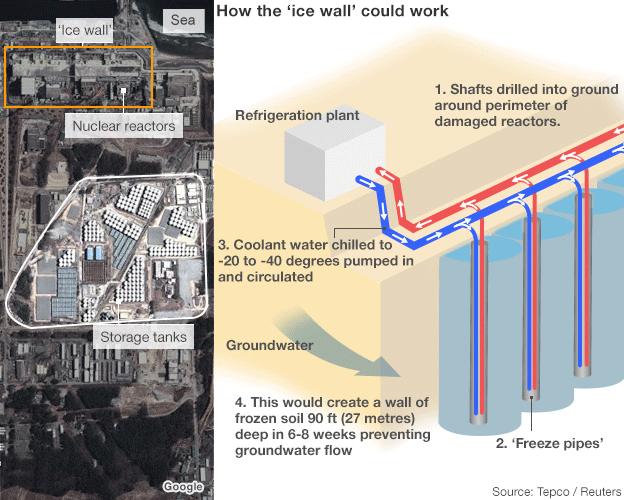Radiation levels hit new high near Fukushima water tanks
- Published

Tepco faces a major challenge to safely store contaminated water at Fukushima
Radiation levels around tanks storing contaminated water at Japan's crippled Fukushima nuclear plant have risen by a fifth to a new high, officials say.
Ground readings near one set of tanks stood at 2,200 millisieverts (mSv) on Tuesday, the plant operator and Japan's nuclear authority said.
Saturday's reading was 1,800 mSv.
Last month, plant operator Tokyo Electric Power Company (Tepco) said it had found highly contaminated water leaking from a storage tank.
Other leaks have also been reported, prompting the government on Tuesday to pledge 47bn yen ($473m, £304m) in funding to tackle the problem.
The spike in radiation levels found on Tuesday was in the same area where the 1,800 mSv level was detected on Saturday, a spokeswoman from Tepco told Bloomberg.
Joanna Gosling explains where the leaks are coming from
The readings are thought to be high enough to provide a lethal radiation dose to someone standing near contaminated areas without protective gear within hours.
But Japan's Nuclear Regulation Authority (NRA) also said the areas were easily contained.
'Drastic measures'
The earthquake and tsunami in March 2011 knocked out cooling systems to reactors at the Fukushima plant, three of which melted down.
Water is now being pumped in to cool the reactors, but storing the resultant large quantities of radioactive water has proved a challenge for Tepco.
The process creates an extra 400 tonnes of contaminated water every day, which must be stored in temporary tanks.
But leaks of contaminated water, both from the tanks, pipes and through damaged structures, have been a persistent problem. Groundwater from the hills surrounding the plant also flows down and into the radioactive areas.
Under the government plan announced on Tuesday, a wall of frozen earth will be created around the reactors using pipes filled with coolant. This aims to prevent groundwater coming into contact with contaminated water being used to cool fuel rods.
Water treatment systems would also be upgraded to tackle the build-up of contaminated water, officials said.
On Wednesday, Japanese Prime Minister Shinzo Abe told journalists in Tokyo that the government was willing "to take drastic measures of a maximum scale" to resolve the issue ahead of the 2020 summer Olympic Games.
"We are aware of concerns over the issue of contaminated water leakages at Fukushima, the government will take charge and will definitely resolve this problem," he said.
Tokyo is a candidate as a host nation for the Olympics, and the decision is expected in days.

- Published3 September 2013
- Published4 September 2013
- Published23 August 2013
- Published22 August 2013
- Published5 August 2013